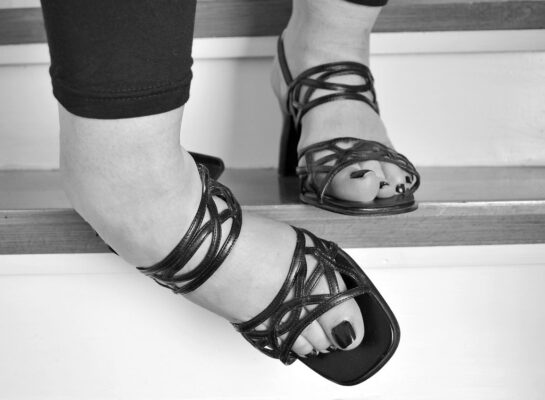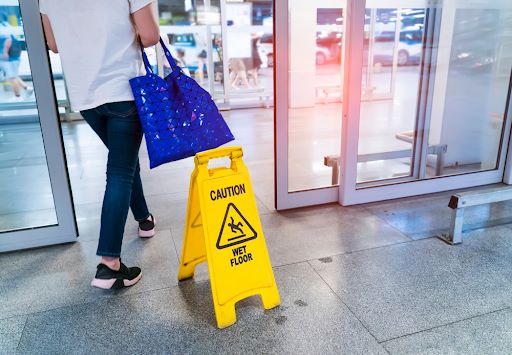A slip-and-fall accident may be more likely the older you get, but it can happen to anyone. According to the National Floor Safety Institute (NFSI), slips and falls occur in all manufacturing and service sectors, with fatal falls most likely in construction, mining, and maintenance. Slips and falls are also a top cause of compensable injury in the trucking industry.
More recent data from the National Safety Council (NSC) shows little change in the landscape: Falls accounted for 21% of preventable deaths in the U.S. in 2022 (second only to poisoning) and were the leading cause of preventable non-fatal injuries, representing 35% of all injuries.
Based on almost 24.5 million (24,458,860) preventable non-fatal injuries reported, over 8.5 million (8,560,601) were slips and falls.
Many slips and falls are unavoidable:
- You slip on an icy sidewalk in good condition despite taking care.
- You faint because of an existing medical condition, causing you to fall over.
- You slip and fall on uneven terrain while hiking.
Sometimes, a slip and fall accident might be caused by the person who suffered the injury:
- You’re not paying attention because you are texting on your phone, causing you to trip or walk into someone else and fall.
- You’re wearing inappropriate footwear, such as high heels, and choose to walk across gravel or down a slope.
- You run down a corridor knowing the floors are currently being mopped, causing you to lose your balance and slip.
Still, many slip-and-fall accidents in Texas occur because of someone else’s negligence.
But when can you claim compensation for a slip and fall injury? We explain what you need to know about Texas slip and fall laws, including how long you have to take legal action, your options for recovering compensation, and whether you can claim if you are partly at fault for your slip and fall accident.
Your Options for Recovering Compensation According to Texas Slip and Fall Accident Laws
When you’re injured in an accident caused by someone else’s negligence, you have two choices:
- File a third-party claim with the property owner’s insurance company.
- File a personal injury lawsuit.
Property owners or controllers (such as businesses that rent premises to conduct business) often possess Commercial General Liability (CGL) coverage. This is a type of insurance policy, and what is included varies by provider and according to each business’s needs. However, it will often cover:
- Property damage and bodily injuries that occur on the business premises or because of a business’s operations.
- Damage or injury caused by a business’s products or operations after the accident has left the premises.
Many policies also include excess liability coverage for losses exceeding a standard CGL policy’s limits and broader coverage to “fill in the gaps,” known as umbrella liability insurance.
Businesses typically opt for a Commercial General Liability policy because it protects them if a person is injured on their premises. A business without liability insurance whose negligence causes a customer, patron, or visitor to suffer an injury faces having to pay hundreds of thousands of dollars or more to compensate a victim for their medical bills, lost wages, and the long-term impact of the accident on their life. Such a scenario can have a massive effect on a business’s reputation and financial standing.
With CGL coverage, an injury victim can recover their losses (or damages) from the insurer instead.
Therefore, the first step for many slip-and-fall accident victims in Texas is to file an insurance claim against the property’s insurer.
However, Texas law does not require all businesses to have general liability coverage. When a business negligently causes your slip and fall accident and does not have insurance, you can recover compensation via a personal injury lawsuit, during which you sue the property owner or controller directly.
You can also file a lawsuit if attempts to negotiate a settlement with the insurance company fail.
The Standard of Liability in Texas Slip and Fall Cases

Slips and falls come under the broader category of premises liability. Property owners and controllers must provide a safe environment for the public. If they fail to do this, they are negligent, and you can hold them accountable for their actions.
What are the Elements of a Slip and Fall Case in Texas?
To successfully claim compensation after a slip and fall accident in Texas, you must prove the following elements:
- Duty of Care: The property owner or controller owed you a duty of care to provide a safe environment.
- Breach of Duty: The property owner breached their duty of care by failing to take reasonable steps to address a hazardous condition. This could include failing to clean up a spill, warn of a danger, or repair a defect.
- Causation: The property owner’s breach of duty directly caused your slip and fall accident. You must show that your injuries would not have occurred if the property owner had fulfilled their duty of care.
- Damages: You suffered actual damages because of your slip and fall accident. This can include medical expenses, lost wages, pain and suffering, and other losses.
Proving these elements requires strong evidence. Our experienced attorneys can help you gather the necessary documentation, including incident reports, medical records, witness statements, and expert testimony, to build a compelling case and establish the property owner’s liability.
However, your entitlement to compensation also depends on what type of visitor you were when your injury happened. Property owners and controllers are broadly responsible for keeping their premises safe and minimizing potential hazards, but the specific duties of property owners vary.
Texas slip and fall laws classify visitors into three categories:
Invitees
Invitees are individuals who enter a property for commercial purposes. You are an invitee if you enter a store to do a grocery shop or a restaurant for a meal or if you are purchasing goods for your business from a supplier. Invitees are owed the highest standard of care. Businesses must regularly inspect their premises, repair any known or reported hazards, and warn of potential dangers as they arise to reduce the risk of injury.
Licensees
Licensees include social guests, door-to-door salespeople, and others who enter a property for non-commercial purposes. Licensees have permission to be on the property and are owed a reasonable standard of care. Property owners do not have to inspect the property, but they must warn of potential hazards and remedy known dangers.
Trespassers
The final category of visitor is the trespasser. Trespassers enter a property without the owner’s consent or knowledge and are owed the lowest duty of care by a property owner.
Why does this matter?
If you are having a meal at a restaurant and slip on a spillage not signposted with wet floor signs, you can claim the restaurant was negligent and recover compensation. Texas law recognizes you as an invitee owed the highest standard of care.
But, you are not protected by the law if you break into an abandoned property and slip while climbing through the window.
The type of visitor you are can significantly affect your entitlement to compensation. Before pursuing a claim against the at-fault party’s insurance company or filing a personal injury lawsuit, the first step is determining what type of visitor you are under the law and whether the property owner was negligent.
What Constitutes an Unreasonably Dangerous Safety Hazard That Can Lead to a Slip and Fall Accident?
In Texas, property owners have a legal duty to ensure their premises are reasonably safe for visitors. When they fail in this duty, and someone is injured as a result, they can be held liable for the damages.
But what exactly constitutes an “unreasonably dangerous safety hazard” in the context of slip and fall accident liability?
Here are some common examples of unreasonably dangerous hazards comprising negligence:
- Wet or slippery surfaces: This is perhaps the most common cause of slip and fall accidents. Spilled liquids, recently mopped floors, or icy patches can all create hazardous conditions. Property owners must promptly clean up spills, warn visitors of wet floors, and de-ice walkways during cold weather.
- Uneven or damaged walking surfaces: Cracked sidewalks, potholes, torn carpeting, or uneven flooring can all pose tripping hazards. Property owners must regularly inspect and maintain their premises to identify and repair any defects.
- Obstructed walkways: Cluttered aisles, misplaced boxes, or poorly placed furniture can obstruct walkways and create a tripping hazard. Property owners must ensure that walkways are clear and free of obstacles.
- Inadequate lighting: Poor lighting can make it difficult to see potential hazards, increasing the risk of a slip and fall accident. Property owners must ensure that their premises are adequately lit, especially in stairwells, hallways, and other areas where visibility may be limited.
- Lack of warning signs: When hazards cannot be addressed immediately, property owners must provide visible warning signs to alert visitors to the danger. Examples include placing cones, caution tape, and warning sights to indicate wet floors, uneven surfaces, or other potential hazards.
If you’ve been injured in a slip and fall accident, it’s crucial to gather evidence to support your claim. This may include taking photos of the hazard, obtaining witness statements, and seeking medical attention for your injuries.
At Patino Law Firm, we have extensive experience handling slip and fall cases. We can help you understand your legal rights and options and fight to secure the compensation you deserve.
The Role of Comparative Negligence under Texas Slip and Fall Law
Comparative negligence is a legal doctrine that applies when accident victims are partly responsible for the accident that caused their injuries.
This is a common scenario that plays out in many types of personal injury cases, like a driver who is hit by a speeding vehicle but was taking a hands-free phone call during the car accident, causing them to be distracted.
In a slip and fall accident, an individual might be liable if they were texting instead of observing their surroundings, causing them to slip because they did not see a wet floor sign.
Alternatively, you might run down an aisle, turn a corner, skid over a spillage, or trip over a store display.
Negligence laws vary by state. Texas adopts the modified comparative negligence law, which prevents accident victims from recovering compensation if they are more than 50% responsible for the accident that caused their injuries. If their fault lies below this cap, the compensation award is reduced accordingly.
For example, if you are 20% at fault and your damages total $200,000, you will receive the remaining 80%, leaving you with $160,000.
The court determines the fault attributed to each party. A judge or jury will examine all the potential contributing factors to the accident.
Let’s take the texting example.
A worker has recently mopped a store floor. The floor is drying fast, but it is dangerous for customers who do not step carefully. The worker places multiple wet floor signs around the area. A person approaches while texting on their cell phone. They round a corner onto the aisle where the caution sign is and keep their head down, staring at their phone the entire time. They do not see the signs and tread on the wet floor, causing them to slip and fall.
In this scenario, the court may find that the store took every reasonable measure to warn of the hazard:
- They placed multiple signs.
- The signs were visible.
- If the injured person had glanced up once after turning into the aisle, they would have seen the signs and the wet floor.
In a personal injury claim, the injured person might be found majorly liable and not recover compensation.
However, what if the floor was so wet that the signs were insufficient to prevent injury?
Let’s imagine the floor was not drying fast, and there was standing water. The excessive amount of water warranted staff to cordon off the area and divert customers so they did not have to walk past the hazard.
In this situation, the person texting on their phone is still partly liable because they were not paying attention. However, the court might find that the accident victim could still have slipped even if they were not texting because the floor was so slippery, and the shop should have done more to prevent an accident from happening. Assuming the store is majorly liable, the injured person can still recover some compensation for their injuries.
Areas in Greater San Antonio We Serve
Proving Your Slip and Fall Claim
To successfully pursue a claim under Texas slip and fall laws, you will need evidence to prove your case. This could include:
- Photographs of the accident scene showing the hazardous condition
- Surveillance footage that captures the incident
- Witness statements from people who saw the accident or the condition that caused it
- Medical records documenting your injuries and the treatment you received.
Whether you pursue an insurance claim against a property owner or controller with general liability insurance or head to court by suing, the more evidence you have supporting your case, the more likely you will secure fair compensation.
Do Texas Slip and Fall Laws Impose a Time Limit for Claiming?
Every state imposes a statute of limitations, which is the time you have to take legal action. The Texas statute of limitations for personal injury is two years from your accident.
But that does not mean you should wait until the clock is set to expire before you explore your options for recovering compensation.
Say you slip on a spilled bottle of lotion in a San Antonio Walmart. You were browsing and staring at the top shelves, not looking at the floor. A staff member was nearby and did not immediately clear up the hazard, warn you or other customers, or place signs or cordon off the area until they could clean the floor. You fall on your back and suffer a spinal cord injury, leaving you needing long-term physical therapy and with chronic pain that makes it unbearable to walk more than a few paces. You previously worked in a warehouse and cannot return to work because you can no longer carry heavy boxes or perform other duties.
The store has insurance, and you intend to file an insurance claim to recover the cost of your medical treatment, your lost wages, and the income you would have earned if you had been able to continue to work.
However, negotiations with the insurance company drag out. The insurer refuses to admit liability, arguing you were majorly responsible for the accident because you should have been paying more attention.
You know that negotiations will not result in a fair settlement offer, but you realize the statute of limitations has recently expired, and it is too late to go to court, even though you have a strong case.
This is the unfortunate reality for many accident victims who leave it too late to speak to an attorney.
Insurance companies do not make money by paying out on claims, so they will do all they can to minimize their clients’ liability.
In many other cases, an insurer will offer to settle the claim and prevent you from suing. However, such offers are typically unfair — insurers will low-ball you to get away with paying out as little as possible, and it may not be enough to cover your future medical bills, let alone compensate you for your pain and suffering and the overall impact of your injury on your life.
That’s why it’s vital to consult a personal injury attorney as soon as possible after your accident. They can explain what Texas’s slip and fall laws mean for you, gather evidence to prove the property owner was negligent, negotiate a fair settlement with stubborn insurers, and file a lawsuit well within the statute of limitations. If negotiations fail, you are entitled to far more compensation, or the property owner does not have insurance, and you wish to sue them directly.
If you’ve been injured in a slip and fall accident in Texas, our personal injury attorney in San Antonio and McAllen can help you get the compensation you deserve. We’re experienced in premises liability claims and will fight to recover every last cent you are owed. Se habla Español, and you won’t pay fees until we win.
Contact us today to book your free, no-obligation case review and see where you stand.


